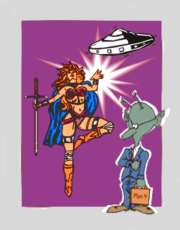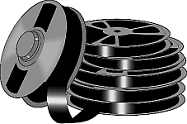Home Search Level 0 Level 1 Level 2 Level 3 Level 4 Level 4Pro Level 5 C/Sing Solo
| Tech terms | Scales | Axioms | Drills | Checksheets | Processes | Prep. lists | C/S terms | C/S tool | Grades | Cramm | Points | KTW | Online |
|
Home Search Level 0 Level 1 Level 2 Level 3 Level 4 Level 4Pro Level 5 C/Sing Solo |
|
|
| Tech terms | Scales | Axioms | Drills | Checksheets | Processes | Prep. lists | C/S terms | C/S tool | Grades | Cramm | Points | KTW | Online | |
The Time Track and
Engram Running
The pc's past is recorded on his Time Track. It is an almost endless and very accurate record. It is recorded in pictures (mental image pictures). It is very complete and with an amazing number of impressions of different perceptions. There are a total of 55 separate types of perceptions - as listed in "Time Track Illustrated". This track is available to the auditor and under the control of his auditing commands. Oddly enough it responds very well to the auditor but only reacts on the pc and is not under his control at all. These rules apply:
The Time Track obeys the auditor.
The Time Track does not obey the pc early on in auditing.
If a motion picture film were 3 Dimensional and had 55 perceptions and could fully react upon the observer, the Time Track could be called a motion picture film. It is at least 350 trillion years long, probably much longer, with about 25 scenes per second. Only a fraction of this track is readily available to the pc by himself.
 |
The Time Track is an |
Some Basics
Free Track. Only a part of this Time Track has an aberrative influence on the pc. Most of it is free of pain and bad adventures and this part is simply called the Free Track. It has no negative effect on the pc. He may recall it or not; that is not the criteria.
Facsimiles. In the pc's mind you are dealing with three basic types of pictures, Facsimiles, Mock-ups and Dub-ins. The pictures, which are actually part of the Time Track - actual experiences - are called facsimiles. These can be Engrams, Secondaries, Locks and even pleasure moments and anything from the pc's free track. But these are the recordings of things the pc went through and actually experienced.Mock-Ups. Any knowingly created mental pictures that are not part of a Time Track are called a Mock-Ups. These are fantasies, imagination, attempts to envision things and the like.
Dub-Ins. Any unknowingly created mental pictures that appears to be a record of the physical universe but are in fact only altered copies of the Time Track are called a Dub-Ins. These are failing or distorted memories, "I think what happened to me was so and so", etc. when in fact it wasn't. The pc can have all kinds of ideas of what must have happened or should have happened and believe this to be true.
engramic
Incidents
The most important classification from the auditor's viewpoint is (1)
Facsimiles, (2) Dub-ins and (3) Mock-ups as described above. These are
three different things to the auditor as they respond and behave quite differently
when run in session. In Engram Clearing our total focus is on facsimiles. This
is important to point out as that makes this type of auditing distinctly
different form Grades auditing 0-4. It also makes it distinctly different from
such activities as different schools of psycho-analysis, including free
association techniques, dream interpretations and many other off-springs of
Freud's work. In Engram running you are primarily interested in recordings. You
are interested in physical universe experiences. They usually read well
and instantly on the Meter, while Mock-ups and Dub-ins read poorly. As far as what the pc
thinks about the whole thing, his ideas, dreams, associations, etc., etc. these
are seen to be thinking activities and not recordings. They are "the smoke
coming off the fire". As good firemen we have to quickly get past the smoke
and find the fire and put it out. That is what we do in Engram running.
 |
Freud and psycho-analysis are mainly |
The subject matter of Engram running and Engram clearing is thus recordings of aberrative incidents. Those are the incidents you want to address and erase. We classify these incidents in three main types: Engrams, Secondaries and Locks. The classification is for practical purposes to make it easer to talk about things. Since they are all "pictures" or Facsimiles and respond the same way to the auditor's commands it makes little difference how they are classified. But this classification do help us to determine how far back on a Chain we are and how far we still have to go - that is all. These facsimiles are all part of the Time Track.
Engrams are those parts of the Time Track that contain moments of pain and unconsciousness.
Secondaries are those parts of the Time Track which contain loss and misemotion. Their intensity is based on earlier engramic experiences.
Key-Ins are those parts of the Time Track which contain the first moment an earlier Engram got restimulated.Locks are those parts of the Time Track which contain complete recordings of Key-ins.
An Incident is the recording of an experience, simple or complex, related by the same subject, location or people, understood to take place in a short and finite time period such as minutes, hours or days.
A Chain is a series of similar incidents of Engrams, Secondaries or Locks. They have something in common that binds them together. They can be far apart in time but the one restimulates the next which in turn restimulates the earlier one and so on.A Basic is the first Incident (Engram, Lock, Overt act) on any Chain. We usually expect to find an Engram.
One particular Chain of incidents has only one Basic. The Basic is the earliest Engram received from or Overt act committed against the subject, area or being.
Basic Basic is the first Engram on the whole Time Track. At this time this is a theoretical concept. But as the theory goes - if we could find and erase the very first Engram of the whole Time Track, that would be the end of the Time Track itself as we know it.
To the pc or auditor the incidents may seem to be in piles on top of each
other or in a filing system. The basic record is however simply part of the
almost endless and consecutive Time Track. The similarity in content is what
apparently piles them up. To the auditor the Time Track responds in a similar
way as a data base. He will "do a search" on a certain criteria and
"Bang!" an incident appears. He will ask for an earlier incident on
the same Chain and "Bang!" it appears right away! The original
records, if you were to look at the 'basic computer files', would be endless lists
of data. There may be 10.000 plus entries between the first incident found and
the next earlier similar one.
 |
|
|
Searching the complete |
Run by Chains the Time |
The Time Track and the PC
Shakespeare said that life was a play. He was right in so far
as the Time Track is a Three Dimensional, 55 perceptions movie. It is somewhat
like what in science fiction is called a hologram where the viewer is in the
middle of it all. The Time Track is a whole series of plays about the pc and
with the pc as the main character. The Time Track's influence upon the preclear removes it
however from the class of pretense and play. It is not only very real, the
content of his Time Track is what holds the pc down and back and depresses him to what he is today.
It can be brutal, savage utterly unbelievable to a point where nobody will believe
it and therefore "it didn't happen". But when you exhaust it for
content, with all its brutality and incredible content, the preclear can recover
- and only then.
With Engram running we are not into science fiction or the occult what so ever.
To a casual reader or audience it may seem that way. We are simply into finding
what we find, running these incidents and empty them for reactive content - come
Hell and High Water - and get the pc safely through it all and out on the other
side. When this is successfully done the pc will recover. There is no other
valid or workable road.
|
A little illustrative story: What comes to mind is the story of Odysseus and the Sirens by the old Greek writer, Homer. On his extended sea travels Odysseus came to the cliffs where the Sirens lived. The Sirens were mythological women. They were known to lure sailors off course by their alluring songs. They would sound like the sailors' loved ones or a seductive woman. The sailors would go mad and immediately set course for the rocks and wreck their ships. Odysseus wanted to hear their songs but knew the dangers. So he had his crew tie him to the mast and had them stuff their own ears so they wouldn't hear him nor the Sirens or anything else. He also instructed them to stay on course - no matter what. When they came close enough the Sirens began their songs. And right on; Odysseus got half mad and screamed to his crew to change course and head for the rocks. His dear wife he hadn't seen for years on end apparently asked him to come to her and go ashore. Then his mother. Neither the man at the helm nor the men at the oars could of course hear him or the Sirens so they stayed on course and took the ship safely away from there. The parallel here is, when running Whole Track incidents you may visit the strangest of places and hear the most amazing stories. To the auditor, as for Odysseus' crew, the thing to do is to stay right on course. The auditor would of course not stuff his ears. Instead he would trust his training, the Meter and the pc's indicators and not much else. As an auditor I used to try to predict what incidents the pc's were about to tell me from the looks of them. This is quite doable. One pc would sway and bend in the chair and I guessed he was in a vehicle. Right on; he was on a space travel. I would see a pc turn red as from fire - right on he was being burned as a witch. One pc was gasping for air as from drowning; she told me all about it moments later. There are an amazing variety of such manifestations. As the pc runs an incident he or she will dramatize and relive it and give you all kinds of clues. These are part of the indicators of course. You can't see the pictures but you can see the effects on the pc. As indicators they are important to the communication, but much less important to the process as a technical procedure. You are just handling facsimiles. You are handling video's neatly boxed so to speak. As an auditor you simply have to stay on course and stick to your procedure by "pulling your oar" in terms of Odysseus. In terms of a store, make sure you get paid for the video and put it in a plastic bag for the customer before you politely wish him a good day, whether he bought a nasty video called "The Chain Saw Murderer Hits Again" or "The Little Mermaid". |
There are other phenomena in the Reactive Mind, such as valences,
circuits and machinery.
There are masses and ridges with a more complex structure (such as GPMs). But these all have their place on the
Time Track and are part of the Time Track. The pc, the thetan, is the effect of all
these recorded experiences and almost all of it is unknown to him.
There is nothing else influencing the preclear than
the Time Track and Present Time. And Present Time, a moment later, is part of
the Time Track.
Creating the Time Track
The preclear makes the Time Track as time goes on. He
does this as an obsessive creation on a sub-awareness level. It is done as an involuntary
continued postulate. It happens below his awareness and is not under his
control.
In the 1950s Ron Hubbard explored various processes designed to expose this mechanism to the pc, the idea being that the pc could be made to undo this mechanism and go Clear as a result. This proved unworkable. The processes produced usually results well short of that and only for a limited number of pc's.
Another method was researched, namely to exteriorize the pc and thus make him leave his Time Track. The results from this were not stable. Usually the state was of short duration and, as discussed under Int Rundown of CT-4 Pro, it could cause serious problems for pc's later on.
The approach that consistently has produced results and Clears is handling the pc's Time Track. The bulk of techniques of the Grades are dedicated to that, from the Recall Grade and onward. On the Grades 0-4 we remove all kinds of charged incidents, including Overts and Withhold and motivator incidents. All these processes are all designed to remove or release charge from the pc's Time Track. As a general rule this is done to Key-out.
But the full road to Clear must include running Engrams to erasure. It must include all the Grades 0-4 as well or the pc will only have a remote chance of handling the heaviest Engram incidents successfully. Besides that the Grades by themselves will give the pc gains in ability he won't obtain from Engram running. Pc's in the past, before 1981, were run on Engrams before the Grades. Sometimes they went Clear before they even got started on their Grades 0-4. But it became clear that they still needed the abilities gained from this auditing. The solution to all this was to arrange the Grades as they are today. You do the Ability Grades 0-4, which handle abilities and key out large portions of the Time Track. Then you do Engram Clearing where you go for erasure of the heaviest and most persistent incidents on the pc's case and as a result you usually end up with erasing the whole Bank.
How Accurate Is the Time Track?
The Time Track is actual. It is made of matter,
energy, space and time as well as thought. Those who cannot confront Mest think
it is composed only of thought. As it can be seen on a Meter it actually
contains an electrical type of energy which is directly measurable on a physics
level. Certain Engram incidents (called Groupers) can make a pc fat and another
type of Engrams (Bouncers) can make the pc thin. This happens if the pc is chronically stuck in
such incidents.
 |
 |
|
The pc's ability to perceive his own
Facsimiles may vary
a |
|
There are no faults in the recordings of the Time Track. It is all there with an amazing number of details. The pc's ability to bring all these details back may vary. Their ability to perceive their own Time Tracks may vary. But all the original recordings are there. Sometimes it will be like such a record is on a hidden away and long forgotten back shelf in a forgotten basement of a forgotten warehouse. Sometimes it is like an open book right under their noses in full color. There are trickery and mechanisms built into the Time Track itself that sometimes makes it hard to access. Snarls can be caused by Grouper incidents. Detours can be caused by Bouncer incidents. Another type of incidents, called Deniers, will post "Do not enter" signs which keeps the pc from looking. The incredibility of some incidents make them look like pure fantasy and at first they may get rejected as such. But what the original recordings contain are impressions from 55 sense channels, including sight, sound, smell, taste, feeling of motion, emotion, any thoughts made at the time, pain, relative position and down the list of the 55 perceptions. It is more than any science fiction writer or Hollywood producer could ever dream about reproducing.
A Grouper is anything which pulls the Time Track into a bundle of yarn. When the
Grouper is gone the Time Track is perceived to
be straight.
Unavailability is caused by the pc's own inability to confront Bouncers and Deniers. A Bouncer throws the pc away. It can be backward, forward, up or down
from the track and so makes it apparently unavailable. A Denier makes a part
of the track unavailable by 'telling the pc' it is not there or it is elsewhere (a
Mis-director) or tells the pc it should not
be viewed.
Groupers, Bouncers and Deniers can be material. They can consist of matter, energy,
space and time in the form of effort, force, mass, delusion, etc. They can also contain
command
phrases (statements that group, bounce or deny). When a Grouper, Bouncer or Denier
are enforced by both material and command phrases they become most
effective, making the Time Track unavailable to the pc.
The Time Track has to be accessed and run as the very first action of Engram Clearing. Unless it can be made available to the pc he can not As-is what is on it and it will remain an aberrative factor to the pc.
|
A Theory About the Time Track The following is a theory or hypothesis. As such it is not part of the technology but can be an inspiration for further research. The thetan as a Static is not part of the physical universe. The Mest universe has the effect upon him that it seems to condense and solidify him. Living in the Mest universe continuously without any rehabilitation causes the thetan to become less reaching - you might say smaller since size and reach are closely connected - and more solid. Since a thetan is basically a Static (meaning a free spirit) it is not a natural thing for him to duplicate matter, energy, space or time, nor certain intentions. He tends to go effect of this in the attempt and thus goes effect to the influences of this universe. The influence itself would be of little consequence if it wasn't because of the Time Track. But since the thetan makes this continued record of matter, energy, space and time he gets caught up in the whole thing. A close inspection of long past incidents will also reveal there have been many ill intended attempts to get the thetan caught up in all this. These incidents are called Implants.
It can be theorized that rhythm is the source of present time, the continuous beat of "Now!" The thetan wants to be in present time due to his desire to have or experience things, to interact and be recognized. There also seem to be reason to believe that he in the distant past has been overwhelmed by a continuous minute rhythm. Present time can in these terms be defined as a response to a continuous rhythm of the physical universe, resulting in Here and Now.
The Time Track can be understood as a response to this rhythm of the universe itself. This was undoubtedly assisted by implants and his own Overt acts and his conviction of the usefulness and need of a continuous record. The thetan began to respond to the physical universe by duplicating matter, energy, space and time and creating such a record. This became an obsessive create. It was an involuntary intention and the creation could at some point be controlled and restimulated by the environment. At some later point he considered this record terribly important and after that happened it became an aberration and could be used to trap him and aberrate him with. So when the thetan gave up on his own ability to know and started to depend on pictures to know it was an aberration. Permanent and Non-Permanent Parts This is what makes up the Time Track. Some parts
are permanently created, but the majority of the track gets recreated when the
thetan's attention is directed to them.
This conflict between the thetan and the Mest universe in itself is the principal unresolved problem and it creates timeless masses which accomplish the basic mechanisms of a trap. The effect of the Time Track upon the thetan can then be seen as being the primary factor that makes a thetan solid, immobile and decisionless.
With this endless record of the past accumulating and forming a gradient of solidification of the thetan he eventually gets weighed down. The physical universe by itself wouldn't entrap him if it wasn't for the Time Track. Actually, as it gives him a nice Havingness, the universe by itself could be quite therapeutic. It apparently takes more than just living in the physical universe to become
aberrated. The main method of causing aberration and entrapment is therefore
found in actions which create or confuse his Time Track. |
||||||||
Working with the Time Track
With the technology we can handle the influences of the Time Track on the thetan and thus rehabilitate him to a large extent. Further research and experiments may push upward the limits of what is possible to reach. Any system which can help and assist the thetan to reduce the charged condition of his own Time Track is valid processing. This statement does not include the use of various mind altering drugs or medications as that does not help the thetan reduce the charged condition but instead seem to reduce his ability to mental creation and at the same time reduces his awareness and ability to make decisions. Any system which would seek to handle the charge by reducing the preclear's awareness and ability to create and make decisions is simply degrading and not valid processing.
So the way to go is to be able to handle, control and work with the thetan in order to make him capable of reducing the charge through him inspecting and As-is aberrative parts of the Time Track, piece by piece.
Handling Time
The first task in Engram running is to
master the handling of Time on the preclear's Time Track. It must be handled
without question, uncertainty or confusion.
Failing to handle the time on the pc's Time Track with confidence, certainty
and without error will result in grouping or denying the Time Track to the pc.
As it was stated in the Axioms in various ways, the
time factor is very important to handle. According to an early axiom, "the single source of aberration is
Time". It is that important. The prime source of ARC breaks in Engram running sessions is
by-passing charge by time mishandling by the auditor. Under this comes not
running the incident which are the basic on a Chain. This becomes an
error in time and reacts on the pc as By-Passed charge.
A smooth and ARC break free session requires gently establishing the correct time and duration of incidents, working one's way down to the earliest incident available and in the process ensure accurate time handling for each earlier incident that is run. This is built into the procedure of R-3-RA itself, the basic process of Engram Clearing. But it is still important that the auditor understands what he is doing and does it with confidence and skill.
There are only a few reasons why auditors have troubles with running Engrams on pc's. Among these are:
1. Q and A with the pain and unconsciousness of incidents.
The auditor has to have enough confront and determination to get the pc through the incident regardless of any obstacles encountered. The old rule was and sill is: "What turns it on will turn it off". If the pc turns on a feeling of terror while running an incident the cure is to get him to continue; because it was the incident that turned it on. Another old rule says: "The way out is the way through". That would apply to the same example. The terror is part of the incident. To park him there, looking into the lions mouth, would be cruel. To run away from the incident will leave the terror as By-passed Charge. He wouldn't escape the lion since it is on his Time Tack; and running away would have the lion chase him and stay exactly the same 4 feet away from his head as when he first contacted it in the incident. "The way out is the way through" means thus, we simply confront the beast and walk straight towards it and it will usually behave as a little kitten. The same rule would apply to a pc seemingly going unconscious. Unconsciousness is part of the content of any Engram. It will run out. It is not uncommon in Engram running that pc's dope off momentarily. This is less a problem when using R-3-RA than it used to be with earlier techniques. In R-3-RA we do extensive pre-assessment using the Meter and that ensures we find something that will run well, deep and relative fast. In 1950 style Engram running auditors didn't have that and as a result the pc would unexpectedly find himself in impressive Time Track scenarios he wasn't quite prepared for. Yet the auditor would apply the above rules and successfully get the pc through it and safely home from his Time Track safari; pc shining from his accomplished adventures and ready to go on a new Engram safari.
Another reason for trouble is:
2. Failing to handle the pc's Time Track for the pc.
The handling of time was discussed above. But how do you do it in Engram running? There are actually three ways the auditor can use to move a pc on his Time Track:
(a) By Significance - the moment something was considered.
(b) By Location - the moment the pc was at a certain location.
(c) By Time alone - years ago, the date, or years before another event.
All three have time in common: "The moment
when you thought _____" "The moment you entered the burning house______" "Two
years before you were wounded in battle" are examples. They all depend on the
time factor. Each mark a clear instant on the pc's Time Track with no mistake
possible. You can handle the Time Track by any one
of these methods, Significance, Location, Time.
The track will respond well to an auditor using any of these methods. Auditors will have trouble
if they can not
grasp the accuracy and speed by which the Time Track responds. If they
wonder if the pc went. If they question the pc's being there. Any fumbling
around will undermine or destroy their command over the pc's Time Track.
If the auditor says, "Go to 14,987,878,383 years 3 months, 8 days 6 hour and
15 minutes ago!"
it will cause just
that to happen when stated clearly and without any doubts. If the auditor starts
to fumble or hesitate or sound doubtful or too impressed about the big numbers the outcome can be doubtful.
In moving the Time Track about, you only move the track. The pc is always in
present time so you don't say, "You will move to". You can say "Move to",
meaning the Time Track. You don't have to say
(but it would be correct) "The Time Track will move to..." In the original
procedure of 1950 they used "The Somatic strip will move to..." The
Somatic strip was the recordings of Somatics on the Track.
In getting to the incident you always use To. "Move To_____."
In running an Engram or incident, you always use through. "Move through
to the end of that incident."
If the auditor doesn't have a good grasp of the Time Track and
its composition, he won't ever be able to run Engrams. So, obviously,
the first thing to learn in Engram running is about the Time Track itself. When the auditor
knows that, he will be able to run Engrams. If the auditor does not know the subject of the Time Track well, then
he can't be taught to run Engrams. You are handling a motion picture projector
and to be able to operate that you have to be familiar and at ease with handling
film. An
auditor just sitting there and being uncertain about what he is really doing will soon have film all over the
place. He will just get tangled up in more film so long as
he doesn't know it is film and that he, not the preclear, is
handling it.
 |
The auditor is handling the Time |
When an auditor has learned this, he will then be able to
learn how to run those small parts of the Time Track called Engrams. If an auditor
can't run a pc through some pleasant experiences on the Track flawlessly, he sure can't
run a pc through the living Hell parts of the Track called Engrams.
An Engram Clearing auditor who can't handle the Time Track is hardly an CT-5 auditor as that's all there is to auditing
Engrams besides handling postulates. This is actually true for any process you are
using. You are handling the Time Track one way or the other. The so-called "bio-chemical approach"
to the mind is a complete misunderstanding. There is only the Time Track to affect.
Bio-chemicals are unpredictable and usually result in a subdued thetan and thus
apparently bring about a result. Sometimes it results in the thetan going
exterior on a compulsive basis, but with an equally disastrous outcome.
 |
Using Medicine and Drugs to handle the
|
There is the thetan, there is his Time Track. The thetan gets
caught in the Time Track as a result of living. The job of the auditor is to free the thetan by
untangle him from his Track. Pc is all wrapped up in film strips. So if you have
to know what you're
untangling the pc from and do your work without a quiver. Unless you do that you're going to have an awful lot of pc's suffocating
and half strangled in all that film and a
lot of auditing losses for both you and your pc's.
Charge and the Time Track
Charge is what is being relieved or removed from the Time
Track. Charge is the stored quantities of energy on the Track. By running the
incidents the auditor enables the pc to As-is or erase it.
When this charge is present in huge amounts the Track overwhelms the pc and
he becomes unable to observe the actual Track. Instead he may experience
different phenomena, such as Dub-in. There is a scale for this. It can be
applied to the pc as a case but also to monitor his progress concerning certain
sections of his Time Track:
(1) NO TRACK - No Charge.
(2) FULL VISIBLE TIME TRACK - Some Charge.
(3) SPORADIC VISIBILITY OF TRACK - Some heavily charged areas.
(4) INVISIBLE TRACK - Very heavily charged areas exist (Black and Invisible Fields).
(5) DUB-IN - Some areas of Track so heavily charged pc is below consciousness in them.
(6) DUB-IN OF DUB-IN - Many areas of Track so heavily charged, the Dub-in is submerged.
(7) ONLY AWARE OF OWN EVALUATIONS - Track too heavily charged to be viewed at all.
(8) UNAWARE - Pc dull, often in a coma.
On this scale the very good, easy to run cases are at
Level (3). Skilled Engram running can handle down to Level (4). Engram running
is useless from Level (4) down.
As State of Case: (1) is of course an ideal state. (2) is the clearest Clear
anybody has ever seen. (3) can run Engrams. (4) can run early track Engrams if the running is skilled. (5) has to be run on
Grades
0-4 and general ARC processes.
(6) has to be run carefully on recall processes. (7) responds to Objectives and the
CCH processes. (8) are best run on reach and withdraw Objective processes.
By following the Grades from Life Repair and up it will be taken care of. Results are best assured when the pc is brought up to a certain level through Grades 0-4. Handling drugs, including the Cleansing Rundown and Objectives early on, is important as drugs is a major factor in shutting off the Time Track. As a note, the shut off caused by drugs is what makes the use of bio-chemicals (such as psychiatric drugs and street drugs) appear to be effective. The pc is actually pushed down on the above scale and his Time Track is completely being submerged.
Most mental studies, such as psycho-analysis, psychiatry and most of clinical psychology, seem to be observations of people at (7) who considered Levels (5) and (6) and (8) as the only possible states of case. Oddly enough they overlooked (7) (their own group) entirely.
On some portions of every Time Track in every
case you will find each of the Levels momentarily expressed. Thus the scale can
also be used as an Indicator in Engram running. Thus (1) would be an erasure. But the
scale was originally designed as a tool to
estimate the pc's state of case. To do that, you estimate his chronic case level and doing so
the scale is useful in programming
a case and determine if he is ready for Engram running. But any case will for
shorter or longer periods of time hit these levels as a
result of processing. There is the temporary case Level. A pc going through a
rough area of Track will momentarily show the manifestations near the bottom of
the scale. When full erasure of an incident is accomplished that piece of track
will appear to be at (1) and the pc in general in better shape.
As Engram running is only recommended on cases on (4) and up it can be seen to be limited to higher level
cases. A full drug handling and Grades 0-4 is what moves the case up to be able to run
Engrams well.
This is the basis of the Grade Chart.
Charge and Case Level
What makes up this scale is entirely amount of charge on a case. The more heavily charged, the lower it falls on the above scale. It is charge that prevents the pc
from confronting the Time Track and submerges the Time Track from view.
Charge is two things (1) it is permanently stored energy or (2) stored
'blueprints' of recreatable energy.
|
|
 |
|
Charge can be like a blueprint that only
gets recreated when |
|
The Meter registers charge. A very high or low Tone Arm, a
sticky or dirty needle, all reveals this charge. The chronic TA position of a
case is an index of chronic charge. The movements of the TA during a session
shows relative charge in different portions of the pc's
Time Track.
But of more interest to an auditor, the Meter registers released charge. You
can see it blowing on the Meter. The blowing down of the
TA, the heavy falls, the loosening needle all show charge being released.
The Meter shows charge contacted (TA goes up) and then charge released (TA
blows down). When the TA goes up or the needle gets tight it reveals charge found but not yet released.
TA going below the 2.0 position also means lots of charge in
restimulation. When the charge is cleaned up through auditing the charge is seen to "blow".
You will see a Blowdown of the TA - and in low TA cases (below 2.0) you will see
a "bow-up" of the TA; it will come back up in normal range. This last
phenomenon is rare in modern auditing, but if you see it, that is what it means.
 |
"The whole cycle of |
Charge which is restimulated but not released causes the case
to "charge up". Charge already on the Time Track is being triggered but is
not yet viewed by the pc. The whole cycle of restimulating charge that is then
blown is the action of auditing. When prior charge is restimulated
but not located or seen, so it can be closely inspected and thereby blow, we
have By-passed Charge and ARC Breaks.
The above scale of charge on the case is the totality of charge. Level (I) has no charge on
it. Level (8) is total charge. The day to day condition of a pc and his case,
his temper, his reaction to things and brightness, depends upon two factors, (a) the totality of
charge on the case and (b) the amount of charge in restimulation. Thus a case
being processed varies in tone by (a) the totality of charge remaining on the
case (b) the amount of charge in restimulation and (c) the amount of charge
blown by processing.
Charge is held in place by the basic on a Chain. If you were to only run later than
the basic incidents charge will be restimulated, then some of the charge will
handled from the running. You have reduced those incidents. But then the
Chain can charge up again and very
little charge is blown permanently. Running too late on a Chain to bring about
erasure is known as "grinding" an
incident. An Engram is getting run, but if it is not basic on a Chain, no
adequate amount of charge is being released. With R-3-RA we have a process that
will find the right Chain to run and quickly bring the pc back to the basic
incident and basic incidents do erase - often in a spectacular manner.
Later than basic incidents are run as part of any Chain. It is the string to
pull. It takes charge off the case (and that particular Chain) by unburdening
it. When charge has come off the pc is capable of finding and running earlier incidents
on that Chain.
No full erasure of incidents later than basic is possible,
but charge can be removed from them providing they are not ground out but
only run lightly a time or two and then an earlier incident on the Chain found
and run. When the basic is found it is erased by going through it many
times. The Basic is the only incident which can be run through over and
over. The later the
incident is - further away from Basic - the lighter it is run.
There is no difference in how you run a
basic incident or a later one. They differ only in the number of times through
you can do with benefit. The Basic is run through many times. A somewhat later Engram
is
only run through a couple
of times. An Engram very late on the Chain usually only needs to be gone through once. Otherwise all
Engrams are "pictures" or facsimiles and whether it is the Basic or not
they are all run exactly the same way.
Charge is released primarily to return a thetan to be in
control of his Time Track. It helps him restore his power of choice, and Engram
Clearing frees him of his most
intimate trap, his own Time Track. You cannot have sane or capable
beings as long as they are trapped and overwhelmed. While this way of thinking may
go against the intentions of slave masters or degraders it is nevertheless true. The universe is not itself a trap. But
there exist beings, who themselves are beaten down and overwhelmed, that uses this universe to degrade others.
The purpose of Engram running is to release the charge which has
accumulated on a case and restore the being to a state where he can appreciate life.
All cases will sooner or later have to be run on Engrams - no
matter what else has to be done. For it is Engrams that make up the core charge
of the Time Track. Those parts of the Time Track we call Engrams are the parts
which overwhelmed the thetan. These contain pain and
unconsciousness; they are therefore the recordings of the moments when a thetan was most
at effect and least at cause. In these moments then the thetan was least able to
confront or be causative.
The Engrams also contain the moments when it would have been wiser to get
out of the way; these are the most degrading moments to his basic powerful
ability to hold a position in space. The Engram invalidated that.
The heaviest ARC breaks a thetan has with the environment and other beings
are usually also Engrams.
 |
Charge is generated between |
Generating Charge
All these things add up to charge and the generation of charge. We have an impulse to withdraw
from something which can't be withdrawn from or a reach towards something which can't be
approached or reached. This forms a two pole system, like a two pole battery,
and it generates current. This
constantly generated current is chronic charge. It works the following way in Engram
running:
(a) The pc's attention is directed in the general direction of such a track record. This causes the current to increase.
(b) The auditor directs the pc's attention more closely and accurately to the incident; the current starts to discharge.
(c) The auditor/pc team finds the basic on the Chain and erases it. That was what composed the poles themselves; by erasing that no further generation is possible by that Chain and it becomes incapable of producing further charge to be restimulated.
When Basic is found and
erased the whole Chain
discharges. The mechanism
is permanently unplugged.
The Must Reach/
Must Withdraw in the
Basic incident held the
+/- Poles in place.
The above are the actions that are supposed to happen in Engram Clearing. If these actions do not occur despite auditing, then there is no case betterment; so it is the auditor's responsibility to make sure they do occur.
The Time Track is created by an involuntary intention of the thetan. It is not only 'ideas' or thought. It exists as a real thing. The Time Track is composed of space, matter, energy, time and thoughts. The thoughts are embedded in the recordings as significance. On the above scale Level (8) is a case where the Time Track is completely pushed out of sight by charge. It goes down to a level where a total unawareness of thought itself exists. At Level (7) awareness of the track is restricted to having opinions about existing charge. At Level (6) (Dub-in of Dub-in) you have all kinds of delusions. You have pictures of pictures of the track being offered; very inaccurate - all due to heavy charge. At Level (5) (Dub-in) the charged condition only allows inaccurate copies of the track to be viewable. At Level (4) charge simply obscures the track. At Level (3) the charge wipes out portions of the track, but they can be recovered. At Level (2) there is so little charge it is only enough to keep the track as a blueprint. At Level (1) there is no charge left and no track to worry about.
A thetan can create energy by his ability to hold two
poles apart. This does not have to be obsessive or automatic. From Level (1) and up
into higher states energy is generated knowingly by the thetan by his ability to hold locations in space and poles apart.
This ability degenerates again if he puts this ability on an automatic or
begins, once more, to make an automatic Time Track. But these actions by
themselves are not capable of aberrating
a thetan until he runs into new violent degradation and entrapment, such as implants. Aberration itself must be
planned for and intended to occur. But the existence
of the Time Track makes it possible for it to happen and stick with him. Thus a
thetan's first real mistake is to consider his own pictures and their recorded
events important. He is perfectly capable of knowing the past without the use of
pictures. Erasing the facsimiles does not mean amnesia. This false datum has
been part of how thetans 'got sold on' the idea of hanging onto their pictures.
The second mistake the thetan made was not eradicate the entrapment
activities taking place. This should be done as to close the door on becoming entrapped
and aberrated again.
Engram Clearing done expertly is a big step towards the state of Clear. You
get down and dirty by going down and handling the living lightening out of
the very real experiences of the Track. In the process you will unburden and
erase a lot of charge and at some point in time reach a moment where the whole
Bank seems to erase. So it is a skill which must be done and done well.
|
Home Search Level 0 Level 1 Level 2 Level 3 Level 4 Level 4Pro Level 5 C/Sing Solo |
|
|
| Tech terms | Scales | Axioms | Drills | Checksheets | Processes | Prep. lists | C/S terms | C/S tool | Grades | Cramm | Points | KTW | Online | |